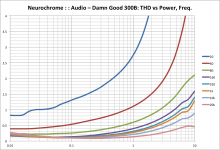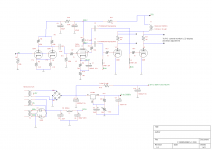Very nice! Do you have the "dirty bits" to the right of 10W? We should expect rapidly increasing distortion when the amp is clipped.
I didn't see the point of running the amp to the point of destruction. You can expect the traces for the higher frequencies to follow the same trend as that of the 40 Hz trace.
I know for 1 kHz, the THD hits 3 % at about 11~12 W.
~Tom
I know for 1 kHz, the THD hits 3 % at about 11~12 W.
~Tom
Last edited:
 RH300B....😕...
RH300B....😕...Wonder what it sounds like..😀
I guess this Hammond lump... would work might be a bit close..
300BX
280VA
800V C.T. @ 288ma.
5V C.T. @ 3A
6.3V C.T. @ 6A
5V C.T. @ 1.2A
5V C.T. @ 1.2A
Regards
M. Gregg
Last edited:
I pulled out my Parallel 300B amps again..(now that I have a way to measure THD with Pete Millette's Sound Card Interface and Visual Analyzer) Here's what I get at the 1% THD mark with a Hammond 1640SE 25 watt transformer. Using the 4 ohm tap into 6.8ohm resistor:
28Hz = 2.5watts
42Hz = 4.1watts
64Hz = 6.4watts
then a miracle happens
80Hz = 13watts and pretty flat at 13 watts from there on out with 1% THD
I hit 3% THD at 17.5watts and 5% at 19.6watts @1000Hz.
My listening experience is in sync with the crappy base numbers here.
28Hz = 2.5watts
42Hz = 4.1watts
64Hz = 6.4watts
then a miracle happens
80Hz = 13watts and pretty flat at 13 watts from there on out with 1% THD
I hit 3% THD at 17.5watts and 5% at 19.6watts @1000Hz.
My listening experience is in sync with the crappy base numbers here.
Attachments
No miracle. Just physics... The LF distortion is caused by the OPT. At higher frequencies it doesn't distort as much.
~Tom
~Tom
Typical of transformers with unspecified power rating! 25W without low frequency limit can be anything....😀 This is another good example why 300B amplifiers cannot be too cheap if one wants best performance.I pulled out my Parallel 300B amps again..(now that I have a way to measure THD with Pete Millette's Sound Card Interface and Visual Analyzer) Here's what I get at the 1% THD mark with a Hammond 1640SE 25 watt transformer. Using the 4 ohm tap into 6.8ohm resistor:
28Hz = 2.5watts
42Hz = 4.1watts
64Hz = 6.4watts
then a miracle happens
80Hz = 13watts and pretty flat at 13 watts from there on out with 1% THD
I hit 3% THD at 17.5watts and 5% at 19.6watts @1000Hz.
My listening experience is in sync with the crappy base numbers here.
The DC current is taking most of the available induction where the core works linearly (typically below 8000 G for E+I cores) and/or the inductance is not enough. As the induction for a given signal increases when the frequency goes down you get more and more distortion and/or the inductance is not enough to maintain most of the effective primary load you get at higher frequency.
If you want more headroom for the signal you need to lower the DC current limiting the max Pout of the amp. If the problem is low inductance you can't do much other than re-gapping the core but this will affect the DC current it can withstand limiting again the max Pout of the amp. If you can't live with it best solution is: get another transformer that can cope with both that DC current and power at lower frequency.
Finally found an old datasheet for the 1640SE from Hammond.
Can they be that wrong in their data or are they not concerned with distortion? What say ye 45?
http://datasheet.octopart.com/1640SE-Hammond-datasheet-19807.pdf
Can they be that wrong in their data or are they not concerned with distortion? What say ye 45?
http://datasheet.octopart.com/1640SE-Hammond-datasheet-19807.pdf
Playing some more. Instead of using my BK 3001 (fairly cheap) Audio generator and using my PC sound card out through Pete Millette's Sound card interface I can actually hit:
19 watts at 5% distortion at 50Hz.
16.9 watts at 5% distortion at 40 Hz and
15.5 watts at 5% distortion at 30 Hz.
19 watts at 5% distortion at 50Hz.
16.9 watts at 5% distortion at 40 Hz and
15.5 watts at 5% distortion at 30 Hz.
Finally found an old datasheet for the 1640SE from Hammond.
Can they be that wrong in their data or are they not concerned with distortion? What say ye 45?
http://datasheet.octopart.com/1640SE-Hammond-datasheet-19807.pdf
Connections look ok. Max DC bias is usually a max current where primary inductance starts to drop consistently so it should avoided. Recommended DC bias is well below that. How much I cannot tell because depends on the core/turns/gap that have been used. Also the power rating depends on what they consider the max induction (DC +AC) at a certain low frequency which will have influence on distortion.
To achieve low distortion with a single 300B at 9W @ 30Hz (about 3% where at 1KHz it was about 2%) I used an EI 120 core (40x50mm) which alone weights about 3.6 Kg (about 8 lbs). The minimum inductance at 50Hz for only 3 mW output was 33H for a 4K primary load. It was designed for max AC + DC induction of 7500 G at 75 mA DC current and 13W at 30Hz.
Playing some more. Instead of using my BK 3001 (fairly cheap) Audio generator and using my PC sound card out through Pete Millette's Sound card interface I can actually hit:
19 watts at 5% distortion at 50Hz.
16.9 watts at 5% distortion at 40 Hz and
15.5 watts at 5% distortion at 30 Hz.
Then it is not so bad at all....
1640SE(A) has only 14H inductance.
Hammond Mfg. - "Classic" Single Ended Tube Output Transformers - (1627 - 1642 Series)
IMHO this is (and 1250Ohm primary impedance) not perfect for 300B PSE.
Hammond Mfg. - "Classic" Single Ended Tube Output Transformers - (1627 - 1642 Series)
IMHO this is (and 1250Ohm primary impedance) not perfect for 300B PSE.
Playing some more. Instead of using my BK 3001 (fairly cheap) Audio generator and using my PC sound card out through Pete Millette's Sound card interface I can actually hit:
19 watts at 5% distortion at 50Hz.
16.9 watts at 5% distortion at 40 Hz and
15.5 watts at 5% distortion at 30 Hz.
Thanks for sharing the actual measurement data, just to make sure, your PSE 300B has no feedback, right?
Just a reminder that the RH300B only has a single 300B and use distortion cancellation between the drver and output stage to get 1% THD at 12W.
Mr. Kitic also sent me a note to say that the distortion without feedback was quite a bit higher in his simulations, so something was wrong with my simulation resiults posted earlier, so I will re-visit the issue when I get a chance - must be something wrong the SPICE models that I used. 🙄
1640SE(A) has only 14H inductance.
Hammond Mfg. - "Classic" Single Ended Tube Output Transformers - (1627 - 1642 Series)
IMHO this is (and 1250Ohm primary impedance) not perfect for 300B PSE.
I disagree. Depends on the operative conditions. The inductance is good enough for a 300B PSE that only has 350R plate resistance and ratio between the inductive reactance and the equivalent Zout at 30Hz is nearly 10 which is very good and not easy to achive with other tubes with higher interanl resistance. A factor of 10 is high enough to guarantee low distortion. The other thing one needs to look at is the induction. The last measurements by MelB are no bad at all for the cost of the transformer.
Just a reminder that the RH300B only has a single 300B and use distortion cancellation between the drver and output stage to get 1% THD at 12W.
One thing to take into account when playing with harmonic cancellation is that in most cases it will not work well for the entire frequency range. One can see it just looking at the power stage only. The driver stage itself can be an issue as well, exspecially if its distortion levels are high.
From the power stage point of view it's pretty easy to figure out why. It happens because at low and high frequency the power device doesn't work exactly into the same load as at 1KHz. The usual resistive loadline is in reality a reactive load even if we do not consider the real speaker load but just a resistor!
One can get very close at higher frequency but it is difficult at low frequency. So, in my opinion, harmonic cancellation is a good tool only if used with moderation. The design itself has to be good enough to work reasonably well without. In other words harmonic cancellation will serve just for fine tuning.
What also has to be remembered is that the degree of feedback will vary with output signal since the varying driver impedance forms one of the legs of the feedback voltage divider against a fixed resistance feedback resistor, so the "best" feedback for the whole amp performance can never be optimized in the way a simple one tone simulation would suggest.
The quoted figures for a Kitic style amplifier can best be described as misleading.
Shoog
The quoted figures for a Kitic style amplifier can best be described as misleading.
Shoog
Last edited:
Thanks for sharing the actual measurement data, just to make sure, your PSE 300B has no feedback, right?
Just a reminder that the RH300B only has a single 300B and use distortion cancellation between the drver and output stage to get 1% THD at 12W.
Mr. Kitic also sent me a note to say that the distortion without feedback was quite a bit higher in his simulations, so something was wrong with my simulation resiults posted earlier, so I will re-visit the issue when I get a chance - must be something wrong the SPICE models that I used. 🙄
jazbo8:
No it has no feedback and I have it wired for 4 ohm output and am using a 6.8 ohm resistor for the load. I do this as best I can calculate my speakers are about 6.5 ohms.
jazbo8:
No it has no feedback and I have it wired for 4 ohm output and am using a 6.8 ohm resistor for the load. I do this as best I can calculate my speakers are about 6.5 ohms.
Thanks, the THD figures are quite decent considering no feedback was used. 🙂
- Home
- Amplifiers
- Tubes / Valves
- RH300B 12W with 1% THD

